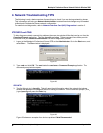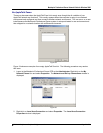
Matchprint Professional Server Network Guide for Windows 2000
2003 Kodak Polychrome Graphics. All rights reserved. Page 21 of 23
Figure 33
Figure 33 shows an example of a successful ping for a specific Hostname.
Automatic Private IP Addressing (APIPA) – 169 IP Address
APIPA is a feature of the Windows 2000 TCP/IP protocol that self-configures an IP address and subnet
mask in the absence of a static configuration and a DHCP server.
APIPA randomly selects a unique IP address from the range 169.254.0.1 through 169.254.255.254 and
sets the subnet mask to 255.255.0.0. APIPA allows home users and small business users to create a
functioning, single subnet TCP/IP network without having to manually configure the TCP/IP protocol or
set up a DHCP server.
Automatic private address configuration
You use APIPA to automate TCP/IP address configuration for single-subnet networks that do not
contain a DHCP server.
By default, a computer running Windows 2000 first tries to contact a DHCP server on the network to
dynamically obtain configuration for each installed network connection.
1) If a DHCP server is reached and the leased configuration is successful, TCP/IP configuration is
completed.
2) If a DHCP server is not reached, the computer instead uses APIPA to automatically configure
TCP/IP. When you use APIPA, Windows 2000 determines an address in the reserved IP address
range from 169.254.0.1 through 169.254.255.254. This address is used as a temporary IP address
configuration until a DHCP server is located. The subnet mask is set to 255.255.0.0.
The APIPA range of IP addresses is reserved by the Internet Assigned Numbers Authority (IANA).
Any IP addresses within this range are not used on the Internet.
APIPA eliminates IP address configuration for single-network small office or home office networks that
are not connected to the Internet.
The DHCP client appears to have automatically assigned itself an IP address that is incorrect for
the current network.
Cause: The Windows 2000 client could not find a DHCP server and has used the APIPA feature to
temporarily configure its IP address.
In some larger networks, disabling APIPA might be desirable for network administration.
Solution: First, use the ping command to test connectivity from the client to the DHCP server. Once
you know the DHCP server is functioning and can be pinged by the client, your next step would be to
either verify or manually attempt to renew the client lease (see IPCONFIG /RELEASE and IPCONFIG
/RENEW above).


















